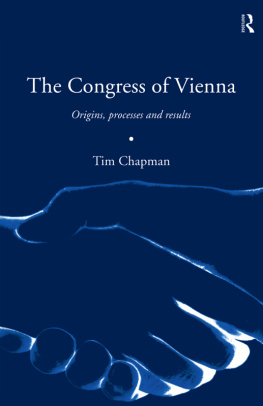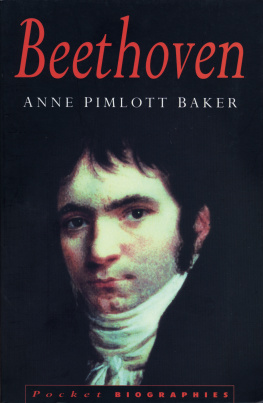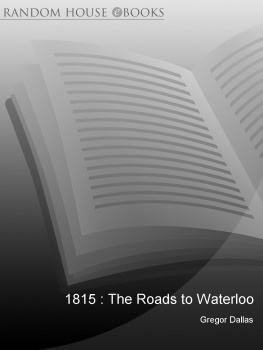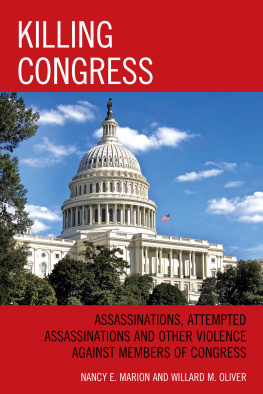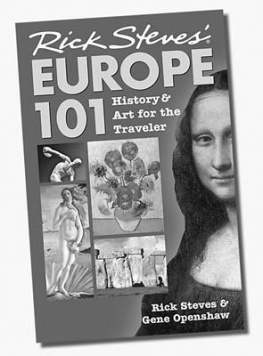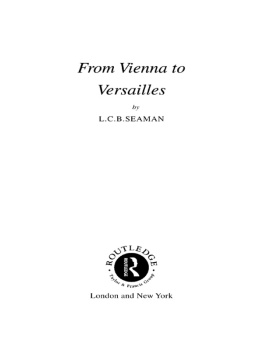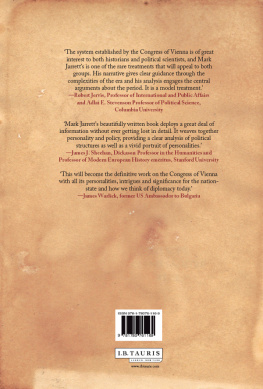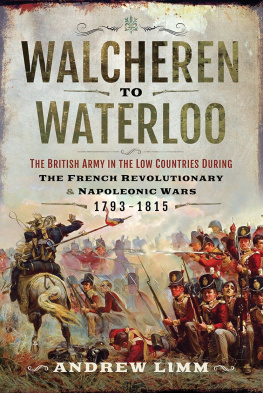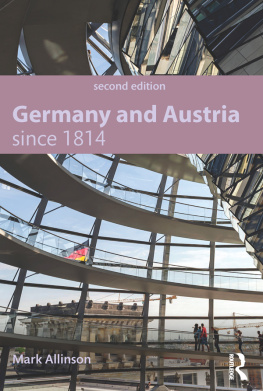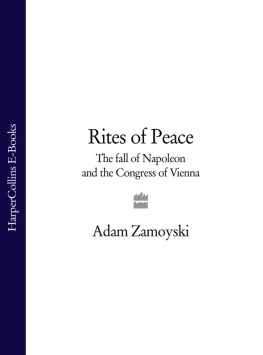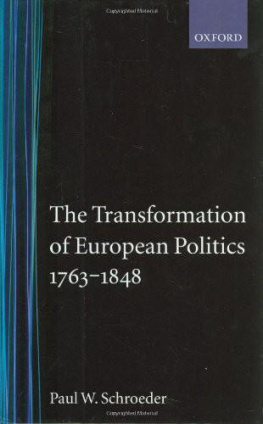THE CONGRESS OF VIENNA
In 181415, after the French Revolutionary and Napoleonic Wars, the leaders of the most important countries in Europe gathered together to redraw the frontiers of their continent. In The Congress of Vienna, Tim Chapman explores the attempt by Britain, Russia, Austria and Prussia to agree Europes new frontiers after almost twenty years of continuous fighting against France.
The Congress of Vienna offers a readable introduction to this difficult topic, providing
- a background to the negotiations from the time of the French Revolution
- a summary of the agreements reached
- assessment of the longer-term consequences
- analysis of the success of the Congress
The author traces the survival and evolution of the Vienna settlement through many revolutions and explains its eventual demise with the emergence of modern Europe.
Tim Chapman teaches History at Wisbech Grammar School.
First published 1998
by Routledge
2 Park Square, Milton Park, Abingdon, Oxon, OX14 4RN
Simultaneously published in the USA and Canada
by Routledge
270 Madison Ave, New York NY 10016
Transferred to Digital Printing 2006
1998 Tim Chapman
All rights reserved. No part of this book may be reprinted
or reproduced or utilized in any form or by any electronic,
mechanical, or other means, now known or hereafter
invented, including photocopying and recording, or in any
information storage or retrieval system, without
permission in writing from the publishers.
British Library Cataloguing in Publication Data
A catalogue record for this book is available
from the British Library
Library of Congress Cataloguing in Publication Data
Chapman, Tim, 1964
The Congress of Vienna: origins, processes, and results/Tim Chapman.
p. cm
Includes bibliographical references and index.
ISBN 0415179939 (hbk.).ISBN 0415179947 (pbk.)
1. Congress of Vienna (1814-1815) 2. Napoleonic Wars, 18001815
Influence. 3. Napoleonic Wars, 18001815Treaties. I. Title.
DC249.C48 1998
940.27dc21 9811040
CIP
ISBN 0415179939 (hbk)
ISBN 0415179947 (pbk)
Publishers Note
The publisher has gone to great lengths to ensure the quality of this reprint but points out that some imperfections in the original may be apparent
War and Revolution in Europe 17891814
The Congress of Vienna was a gathering of all the major states of Europe to draw up a peace settlement at the end of the wars against Napoleon in 181415. It was attended by the four main allies Britain, Russia, Austria and Prussia which were the countries mostly responsible for the defeat of Napoleonic France, the state that had caused the wars. Several minor states that had fought with the victorious allies such as Spain, Portugal and Sweden were also present and most of the remaining countries of Europe sent delegations.
Importance and Scope of the Congress of Vienna
It was one of the most important meetings in European history, comparable to the Versailles peace conferences after the First World War or, earlier, the Treaty of Utrecht (1714). It not only set out the way in which France was to be treated after launching twenty years of war following the 1789 Revolution and the subsequent rise of Napoleon; it reconstructed the frontiers of states that spread across the central and eastern areas of the continent and restored many of the former rulers. It also set out the fate of a great many colonies around the world. There was a huge amount at stake.
Some countries that had been invaded and abolished by Napoleon never reappeared; others were recast in larger or smaller forms while at the same time the largest states looked for bounty and rewards for having won the war. In the complex discussions that took place at Vienna there was a battle for the principles upon which the new Europe was to be based. And, in the midst of this conference of power-brokers, there was one of the most glittering displays of Society figures and leading members of the aristocracy ever seen on the continent.
It was a momentous occasion and one that turned out to be highly successful. It played a major part in making 1815 a turning-point in European history as a long period of war was brought to a close and it was followed by almost a century of peace. The next general war between Europes leading states was the Great War of 191418. Many students of European history in the nineteenth century begin in 1815, in line with much of the historiography of the period; after all, the map of Europe that emerged in 1815 was the starting-point for great changes later in the century that were wrought by the unification of Italy and Germany.
However, setting 1815 as the point to begin a course is in many ways misleading because it marked above all the end of an era, not the start of a new one. The peacemakers of 1815 were men who were backward-looking and conservative, who were concerned to put right the mistakes and misdeeds of the past that they themselves had witnessed and fought against. Their view was coloured by their own bitter experience of war and revolution. They did not see their task as being to reinvent Europe for the future or to pander to the dangerous new ideas that the French Revolution had spread; rather, they wanted to restore Europe to peace by inflicting limits on France and by strengthening their own defences. They did not want a new Europe so much as a better version of the old one.
In order to understand the Congress of Vienna, then, it is essential briefly to retrace the key developments in Europe from 1789 that informed the peace of 1815. As the peacemakers themselves saw the situation, there were two basic problems. First, they had to contend with the ideas of the French Revolution as they had begun to take root in the populations that the French had conquered, and especially within France itself. Second, they had to find ways to restrict the possibility of France (or any other state) mounting another war as devastating as the last. Of the two problems, the second was the one that they took most seriously at Vienna, partly because it was the one that, in practical terms, they could do most to combat. It was to be left to the rulers of individual states to deal with internal problems.
The French Revolution
By tradition, the French Revolution has been portrayed as the storming of the Bastille on 14 July 1789. This is at best a shorthand explanation for the huge changes in France from the 1780s until the execution of King Louis XVI in 1793. Historical research has shown that there was not just one outbreak of revolution but a series of rebellions against the king and the old system of rule (called the ancien rgime) by different classes of people and for different reasons. The cumulative effect of these protests was for confrontation and then conflict to emerge with the king, and this situation, initially led by the nobility, developed its own momentum and subsequently revolutionised France. This had not been the aim of the nobilitys original protests against the king.
The first group of people in France to rebel against the king was the nobility. In the eighteenth century, its members enjoyed privileges that the ordinary people in society did not share. The nobles were spared paying certain taxes, such as the

